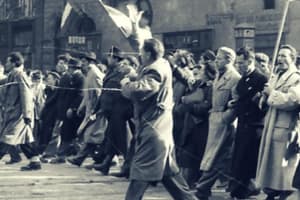Podcast
Questions and Answers
Which of the following best describes the primary Soviet motivation for establishing control over Central and Eastern Europe after World War II?
Which of the following best describes the primary Soviet motivation for establishing control over Central and Eastern Europe after World War II?
- To integrate the region into a new, unified European federation.
- To establish a neutral zone that would mediate disputes between the East and West.
- To foster democratic governments and promote free-market economies across the region.
- To create a buffer zone against potential Western aggression and expand communist influence. (correct)
Which method was NOT a typical means by which the Soviet Union exerted control over its satellite states in Eastern Europe during the period of 1945-1955?
Which method was NOT a typical means by which the Soviet Union exerted control over its satellite states in Eastern Europe during the period of 1945-1955?
- Deployment of the Red Army to suppress dissent and enforce compliance.
- Rigging elections to ensure communist parties gained control of governments.
- Use of secret police forces like the NKVD/KGB to eliminate political opposition.
- Implementation of economic policies designed to benefit the satellite states' economies. (correct)
How did the Soviet Union use economic policies to maintain its control over Eastern Europe?
How did the Soviet Union use economic policies to maintain its control over Eastern Europe?
- By providing substantial financial aid packages that modernized Eastern European industries.
- By establishing COMECON to ensure economic exploitation and integration with the Soviet economy. (correct)
- By implementing a 'Marshall Plan' for Eastern Europe.
- By encouraging free trade agreements between Eastern European countries and Western nations.
What role did censorship and propaganda play in the Soviet Union's strategy for controlling Eastern Europe?
What role did censorship and propaganda play in the Soviet Union's strategy for controlling Eastern Europe?
Which of the following actions taken by the Soviet Union best demonstrates its commitment to ideological expansion in Eastern Europe?
Which of the following actions taken by the Soviet Union best demonstrates its commitment to ideological expansion in Eastern Europe?
How did the Soviet Union's need for post-WWII reconstruction influence its policies in Eastern Europe?
How did the Soviet Union's need for post-WWII reconstruction influence its policies in Eastern Europe?
Considering the Soviet Union's motives for controlling Eastern Europe, which factor was MOST driven by historical experience?
Considering the Soviet Union's motives for controlling Eastern Europe, which factor was MOST driven by historical experience?
Which outcome in Eastern Europe between 1945 and 1955 was LEAST aligned with the stated goals of the United Nations?
Which outcome in Eastern Europe between 1945 and 1955 was LEAST aligned with the stated goals of the United Nations?
Which of the following best describes the primary goal of COMECON?
Which of the following best describes the primary goal of COMECON?
What was the significance of Yugoslavia's expulsion from Cominform in 1948?
What was the significance of Yugoslavia's expulsion from Cominform in 1948?
In what way did the Warsaw Pact intensify the Cold War?
In what way did the Warsaw Pact intensify the Cold War?
Which of the following policies best represents the 'Stalinist policies' imposed across Eastern Europe?
Which of the following policies best represents the 'Stalinist policies' imposed across Eastern Europe?
Why did Stalin attempt to pressure Tito after Yugoslavia liberated itself?
Why did Stalin attempt to pressure Tito after Yugoslavia liberated itself?
How did COMECON affect the economic development of Eastern European countries?
How did COMECON affect the economic development of Eastern European countries?
Which event directly led to the formation of the Warsaw Pact in 1955?
Which event directly led to the formation of the Warsaw Pact in 1955?
What did Tito emphasize in his own socialist model?
What did Tito emphasize in his own socialist model?
What was the role of show trials and purges in the Soviet model of governance imposed across Eastern Europe?
What was the role of show trials and purges in the Soviet model of governance imposed across Eastern Europe?
How did Tito leverage the Marshall Plan funds and the Non-Aligned Movement to benefit Yugoslavia after its split from the USSR?
How did Tito leverage the Marshall Plan funds and the Non-Aligned Movement to benefit Yugoslavia after its split from the USSR?
Flashcards
Buffer Zone
Buffer Zone
Post-WWII, the USSR aimed to create a protective ring of communist countries to prevent invasions from the West.
Ideological Expansion
Ideological Expansion
The belief in spreading communism worldwide to counter capitalism, a core goal of Stalin and the USSR.
Economic Exploitation
Economic Exploitation
The USSR's use of Eastern European nations' resources, industries, and labor to rebuild its own economy after WWII.
Political Dominance
Political Dominance
Signup and view all the flashcards
Secret Police & Repression
Secret Police & Repression
Signup and view all the flashcards
Censorship & Propaganda
Censorship & Propaganda
Signup and view all the flashcards
Soviet Satellite States
Soviet Satellite States
Signup and view all the flashcards
Poland (1947)
Poland (1947)
Signup and view all the flashcards
1948 Czechoslovak Coup
1948 Czechoslovak Coup
Signup and view all the flashcards
COMECON's Purpose
COMECON's Purpose
Signup and view all the flashcards
Impact of COMECON
Impact of COMECON
Signup and view all the flashcards
Warsaw Pact (1955)
Warsaw Pact (1955)
Signup and view all the flashcards
Purpose of Warsaw Pact
Purpose of Warsaw Pact
Signup and view all the flashcards
Josip Broz Tito
Josip Broz Tito
Signup and view all the flashcards
Tito-Stalin Split (1948)
Tito-Stalin Split (1948)
Signup and view all the flashcards
Tito's Socialist Model
Tito's Socialist Model
Signup and view all the flashcards
Non-Aligned Movement
Non-Aligned Movement
Signup and view all the flashcards
Significance of Tito's Defiance
Significance of Tito's Defiance
Signup and view all the flashcards
Study Notes
- Domination occurred from 1945-1955
Motives for Soviet Control
- The USSR aimed to expand influence over Central and Eastern Europe post-WWII
- Key motives included security, ideological expansion, power politics, and economic exploitation
Security and Defense
- The USSR, invaded twice in the 20th century, sought a buffer zone of friendly communist states
- This buffer aimed to prevent future invasions and act as a defense against Western aggression
Ideological Expansion
- Stalin aimed to expand communism globally to counter Western capitalism
- Establishing communist regimes in Eastern Europe would strengthen the Soviet bloc
Power Politics & Influence
- Control over Eastern Europe increased the USSR’s global standing
- This control allowed the USSR to challenge Western dominance during the Cold War rivalry with the USA
Economic Exploitation
- The USSR needed raw materials, industrial resources, and manpower to rebuild after WWII
- Soviet control facilitated economic extraction from Eastern Europe through COMECON
Extent and Nature of Soviet Control
- Soviet control varied across Eastern European countries, with common patterns emerging
Methods of Control
- Political Dominance: Communist parties gained control through rigged elections and intimidation
- Secret Police & Repression: The NKVD/KGB and local security forces eliminated opposition
Methods of Control continued
- Censorship & Propaganda: Anti-Soviet ideas were suppressed, and pro-communist propaganda dominated media
- Military Presence: The Red Army was stationed to enforce compliance
Soviet Satellite States
- Puppet governments were established in Eastern European countries
Soviet Satellite States - Specific Countries
- Poland (1947): Communist takeover via rigged elections
- East Germany (GDR) (1949): Established after the Berlin Blockade
- Czechoslovakia (1948): Communist coup backed by the USSR
- Hungary (1947–49): Rigged elections and repression of non-communists occured
- Romania (1947): The monarchy was abolished, and a communist dictatorship was installed
- Bulgaria (1946): The monarchy was abolished, and communists took control
- Albania (1946): Communist regime aligned with the USSR, later shifted towards China
- Yugoslavia, under Tito, was an exception
Political Control: Communist Governments
- The Soviet model of governance was imposed across Eastern Europe
- One-party rule: Communist parties were the only legal political entities
- Collectivization of agriculture, heavy industrialization, and suppression of dissent took place through Stalinist policies
- Show trials & purges: Leaders who resisted Moscow’s orders were executed or imprisoned
Economic Control: COMECON
- Established in 1949 as a Soviet response to the Marshall Plan
- Aims were to integrate the economies of Eastern Europe under Soviet leadership
- Promoted economic specialization to ensure dependency on the USSR
Impact of COMECON
- Trade was directed towards the USSR rather than Western markets
- Countries were forced to produce goods benefiting the Soviet economy
- Economic inefficiencies led to stagnation
Military Control: The Warsaw Pact
- Formed in 1955 in response to West Germany joining NATO
- A military alliance of Eastern Bloc countries was placed under Soviet command
Member States of Warsaw Pact
- USSR, Poland, East Germany, Czechoslovakia, Hungary, Romania, Bulgaria, Albania (left in 1968)
Purpose and Significance of Warsaw Pact
- It formalized Soviet military control over Eastern Europe
- It allowed for Soviet intervention in member states if communist rule was threatened
- It strengthened the division between Eastern and Western Europe
- It provided justification for military crackdowns and intensified the Cold War arms race
Yugoslavia’s Challenge to Soviet Control
- Tito was communist but not taking direct orders from Stalin
- Yugoslavia liberated itself, leading to a sense of independence
Break with the USSR
- 1948: Tito-Stalin Split occurred, Yugoslavia was expelled from Cominform
- Stalin attempted to pressure Tito through economic sanctions and political isolation
- Tito implemented worker self-management
Western Support & Non-Alignment
- After breaking with Stalin, Tito turned Westward for economic aid
- Tito co-founded the Non-Aligned Movement to position Yugoslavia between the US and USSR
Consequences of Yugoslavia's Challenge
- Yugoslavia remained communist but independent from Moscow
- Demonstrated that Soviet control was not absolute
- Encouraged later resistance in Eastern Europe
Conclusion: Impact of Soviet Domination
- Totalitarian Control: Eastern Europe became a Soviet-dominated bloc with little political freedom.
- Economic Dependence: COMECON ensured reliance on the USSR, limiting economic growth.
- Militarization took place as the Warsaw Pact formalized Soviet military dominance.
- Resistance & Dissent: Tito’s Yugoslavia showed that Soviet authority could be challenged.
- Escalation of the Cold War: Soviet control deepened divisions between East and West, leading to increased tensions with NATO.
Studying That Suits You
Use AI to generate personalized quizzes and flashcards to suit your learning preferences.
Description
The USSR's motives for controlling Central and Eastern Europe post-WWII included security, ideological expansion, and power politics. The Soviets sought a buffer zone against Western aggression and aimed to expand communism globally. Economic exploitation also played a role.




